It seems we can’t find what you’re looking for. Perhaps searching can help.
Sign Up for newsletter!
Subscribe to get the latest eBook!
Hotline






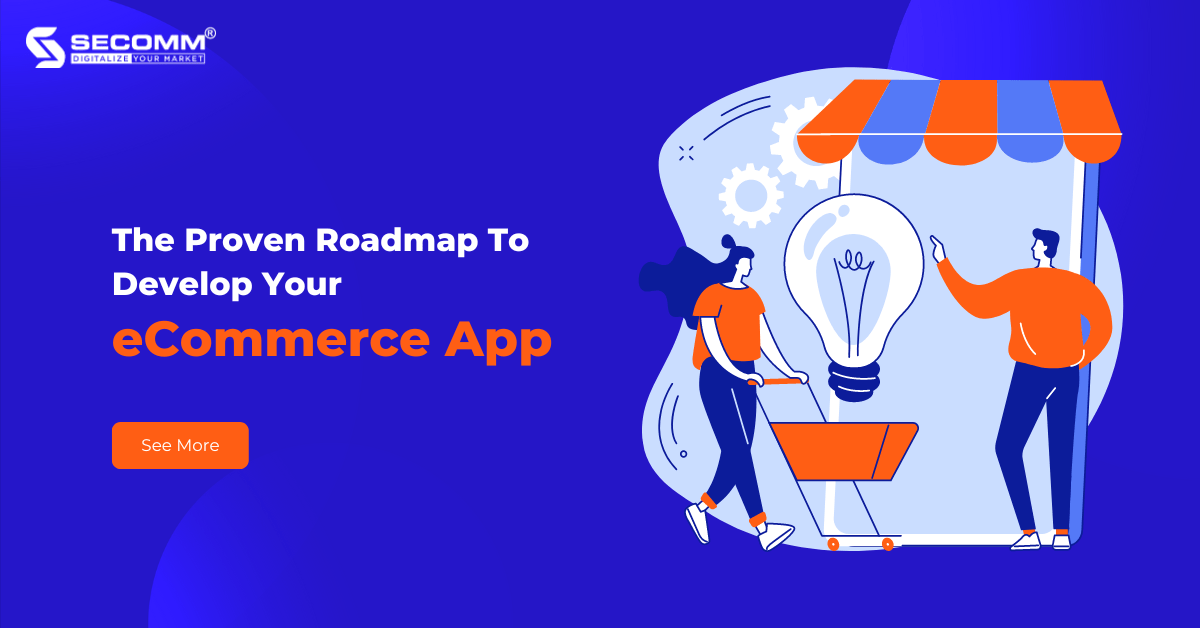
Facing the boom of Mobile Commerce, businesses now have two choices: to build an eCommerce app to adapt to this boom or to ignore it and gradually fall behind.
According to Insider Intelligence’s forecast, mobile commerce market sales will reach $534.18 billion in 2024, of which two devices contributing to this incredible number are smartphones and tablets. Smartphones alone account for 87.2% of mobile commerce sales. These figures are the most convincing answer to the above consideration: Yes, businesses need to build an eCommerce app.
Building an eCommerce app requires a lot of effort and serious work because it is a complex process with many stages and the involvement of many relevant. Below are 8 summarized implementation steps that will help businesses understand the building process of a mobile shopping app to make their business operation more effective.
The first step of the process is to determine the objective of the mobile app, including deciding which products will be sold through the app and identifying the target audience. This way, businesses can build an app that meets their needs and quickly achieves the objective.
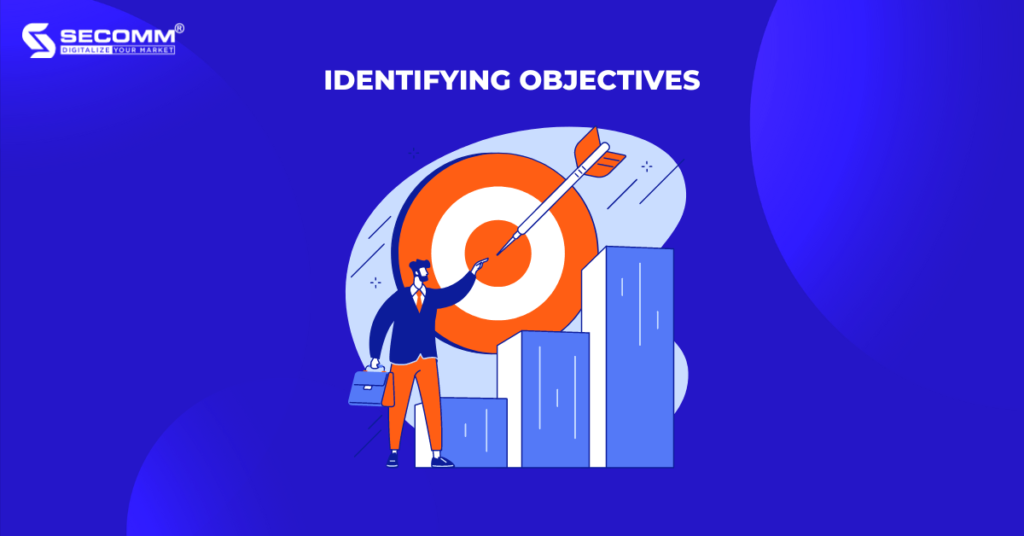
Businesses should do market research to understand their target audience’s needs, preferences, and behaviors in various ways, such as through surveys, interviews, etc. It helps them define the app’s features and the marketing strategies to promote it. Moreover, businesses should find the app’s unique selling points that differentiate it from its competitors, making it easy to attract potential customers and stand out.
After identifying the objectives, the business proceeds to the next step: identifying the vital features of the eCommerce app. Here are some recommendations:
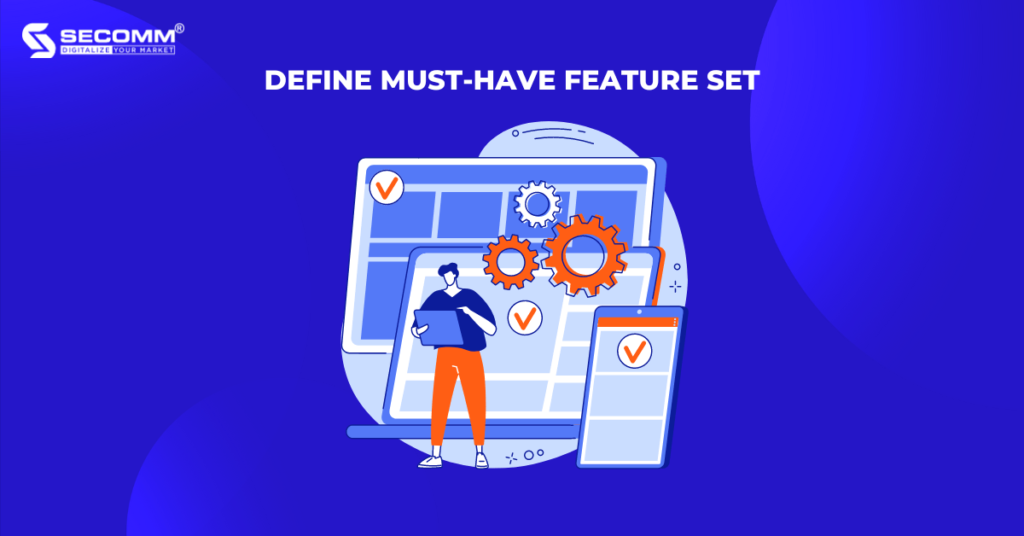
The selection of a platform for building an eCommerce app depends on many factors, including target customers, budget, development stage, necessary features, expansion needs, etc. iOS and Android are two popular platforms in today’s market. In most cases, businesses will build eCommerce apps on both platforms. However, those with limited resources, start with one platform first and then expand to the other later.
Additionally, if a business is targeting customers in the European and North American markets, iOS would be the right choice because iOS dominates these markets. However, because Android has a superior market share in Asia, businesses with plans to penetrate the Asian market should consider choosing Android.
Any business looking to build an eCommerce app will have to choose between a Native app and a Hybrid app. Developing a Native app refers to building a specific app for a specific platform (iOS & Android), using the respective programming languages of the platform – Swift/Objective-C for iOS and Java/Kotlin for Android. Native apps can provide great performance and user experience as they are optimized for the specific platform the app is built on. However, building Native apps can be costly and time-consuming.
Developing a Hybrid app involves building a single app that works on both iOS and Android platforms, using web technologies like HTML, CSS, and JavaScript. Hybrid apps can speed up the development cycle and be less expensive in terms of budget and time compared to native apps. However, Hybrid apps cannot provide the same performance and user experience as Native apps.
Therefore, the choice between developing a Native app or a Hybrid app depends on the budget, development process, and the desired user experience. If the business has a surplus budget to invest in user experience, then developing a Native app is a good choice. However, if the business needs to bring its eCommerce app to the market quickly but has budget constraints, then it should focus on developing a Hybrid app.
Related Reading: Native App & Hybrid App: Key Differences, Pros & Cons
In the next step, businesses decide whether to use an in-house team or collaborate with a specialized agency, which depends on the budget, experience, expertise, and resources. Below are some pros and cons of the two options: In-housing and Outsourcing.
Pros:
Cons:
Pros:
Cons:
The UI/UX design of an eCommerce app refers to creating a visually appealing and user-friendly interface to help users easily search for and purchase products. Here are some suggestions for businesses to consider when designing the UI/UX for eCommerce apps:

In eCommerce app development, MVP stands for Minimum Viable Product, which is typically a condensed version of the app that is launched to the market before the official launch of the full app. Building an MVP for an eCommerce app usually focuses on developing the core features and ensuring those features work effectively before adding additional features.
As listed, the most crucial core features may include a product catalog, search bar, shopping cart, payment methods, etc. When releasing an MVP, the business must ensure that it is error-free and meets the needs of the target customers. The goal of an MVP is to understand the customer’s thoughts on the product, minimize risk, and allocate resources effectively before launching the full product to the market.

After building and releasing the MVP, businesses should collect feedback from users through various channels such as social media, surveys, or reviews on the App Store or Google Play to gather their opinions on the experience when using the eCommerce app. Moreover, businesses should carefully review the feedback and use it to make decisions about how to improve the app. In particular, they should prioritize the most important issues users are facing and resolve them quickly.

After gathering and reviewing user feedback, businesses can will refine the app and conduct a second round of testing to ensure the app performs well and the improvements have enhanced the user experience. Once the refining and second round of testing is done, businesses can release the product to the market and run marketing campaigns to reach target customers. However, the business needs to closely monitor the performance of the eCommerce app and regularly collect feedback from customers while continuously improving to meet the ever-changing demand of users and maintain a competitive advantage in the market.
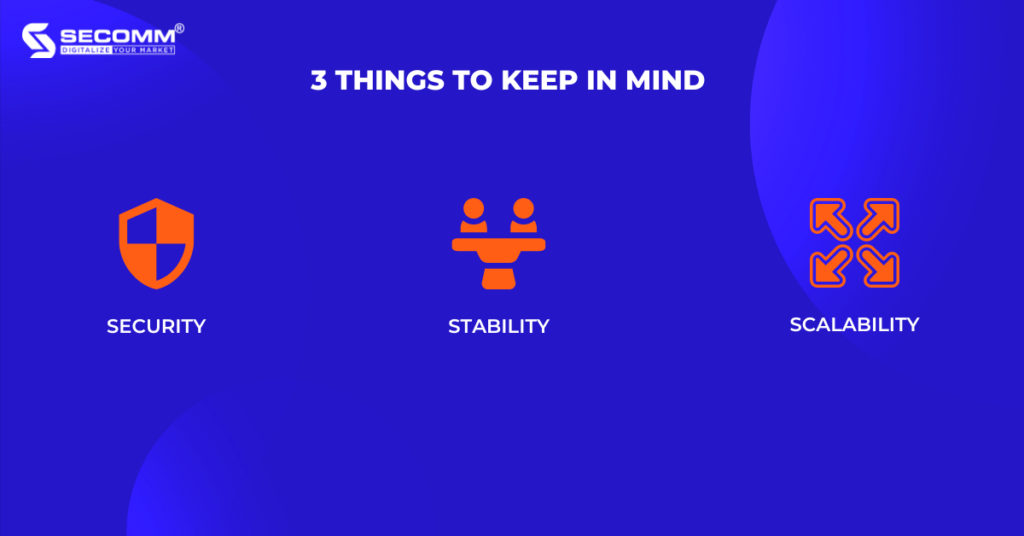
It is a top priority factor that businesses should put their minds to when building an eCommerce application. When users download, register an account, and start using the app, their private data such as login information, personal information, and payment information will be stored on the system. Therefore, businesses should comply with general regulations related to security issues and provide customer information as well as deploy secure payment gateways, and use SSL encryption or two-factor authentication to protect user data of the eCommerce app.
The stability and reliability of an eCommerce app are crucial for a business to provide an incredible user experience. Customers typically prefer apps that run smoothly without any bugs or errors. However, releasing a flawless eCommerce app without any bugs is unrealistic. Therefore, businesses need to conduct thorough testing to identify and fix any issues before launching, while also regularly maintaining and updating the app to improve its performance and prevent or correct any errors that may arise.
This is the ability of an eCommerce app to handle increasing traffic, user volume, and shopping transactions without affecting the performance or functionality of the app. When getting started, businesses should predict the app’s future growth and place to build an app that is easily scalable when necessary. Moreover, businesses need to plan for the addition of advanced features to meet expansion needs.
In summary, security, stability, and scalability are three factors to consider when building an eCommerce app. By focusing on these three factors, businesses can provide customers with a safe, reliable, and scalable app that corresponds to the development of the business.
Above is the general process of 8 steps for building an eCommerce app with some important notes during the implementation. With years of experience implementing eCommerce for businesses from many countries, SECOMM understands the difficulties businesses will face when implementing eCommerce apps.
Contact us today for a free consultation.
 2
2
 4,126
4,126
 1
1
 1
1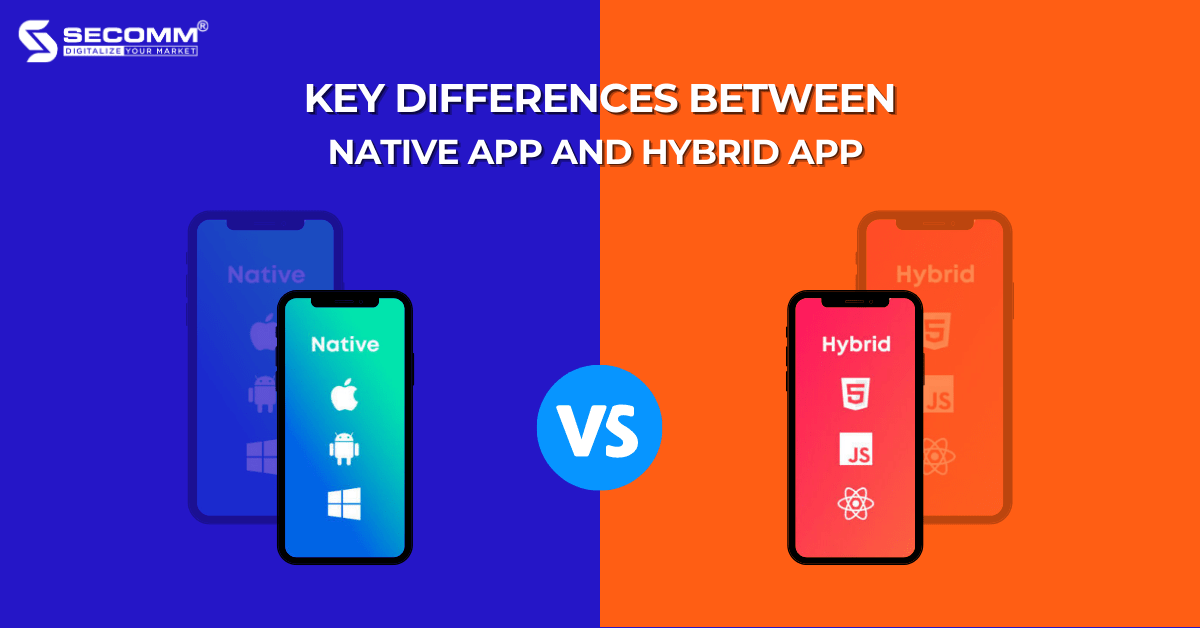
According to Statista, by 2023, there will be approximately 6.9 billion smartphone users worldwide, which will lead to the emergence of mobile apps to enrich user experience. That is why many businesses find ways to build and develop mobile apps to interact with their customers. However, with many platforms and devices around, mobile app development can be a complex and costly process. There are two most popular types of mobile apps including Native Apps and Hybrid Apps.
Both apps have their own advantages and disadvantages, so businesses should consider their demand and resources to choose the right type of app.
Native app is a type of mobile application that is developed specifically for a particular platform or operating system, such as iOS or Android. Native apps use different programming languages depending on the platform they are built on: Objective-C or Swift are the main programming languages for iOS, while Java or Kotlin are the main programming languages for Android.
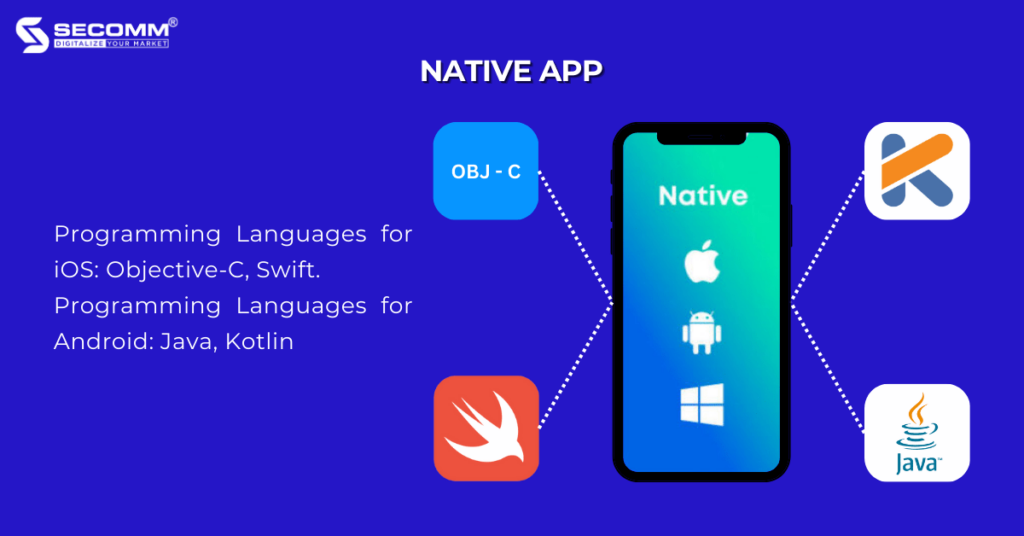
In addition to outstanding advantages, Native apps still have some limitations to be aware of:
Native apps will be suitable for businesses that want to build mobile apps with high performance, diverse features, and a focus on user experience. However, this choice requires a lot of development and maintenance costs, as well as significant time and effort to be put in.
Hybrid app is a type of mobile application built using web technologies such as HTML, CSS, and JavaScript, and then packaged in a Native app container. This allows hybrid apps to run on multiple platforms or different operating systems, including iOS and Android.
Frameworks for developing hybrid apps include React Native, Flutter, Xamarin, and Ionic.
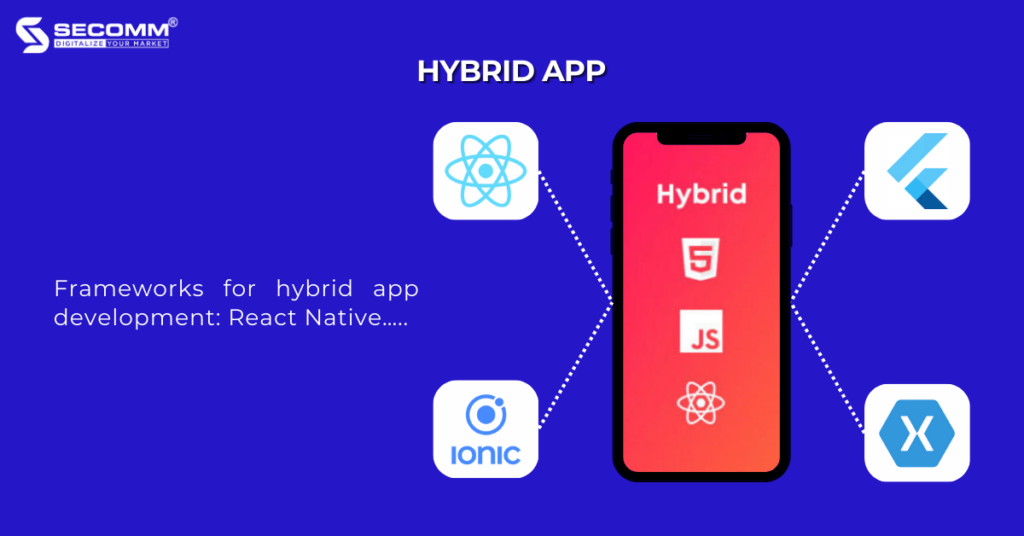
In addition to the advantages mentioned above, hybrid apps also have some drawbacks that businesses need to consider when building them.
Hybrid apps are a good choice for businesses that want to create a mobile app that works on multiple platforms and devices, with a faster development time and lower costs than native apps. However, hybrid apps still have many limitations in terms of performance, user experience, etc. Therefore, businesses should consider this before deciding to build a hybrid app.

Facing the rapid development of mobile apps, quickly building a proprietary app is an urgent mission for every business. With the set of advantages and disadvantages summarized of the two most popular types of applications today: Native app and Hybrid app, the decision will depend on the purpose of each business.
SECOMM has gained many years of experience implementing eCommerce for many customers in many countries, understanding the difficulties and challenges each business faces when deploying mobile applications.
Contact us today to receive a free consultation.
 2
2
 6,517
6,517
 1
1
 1
1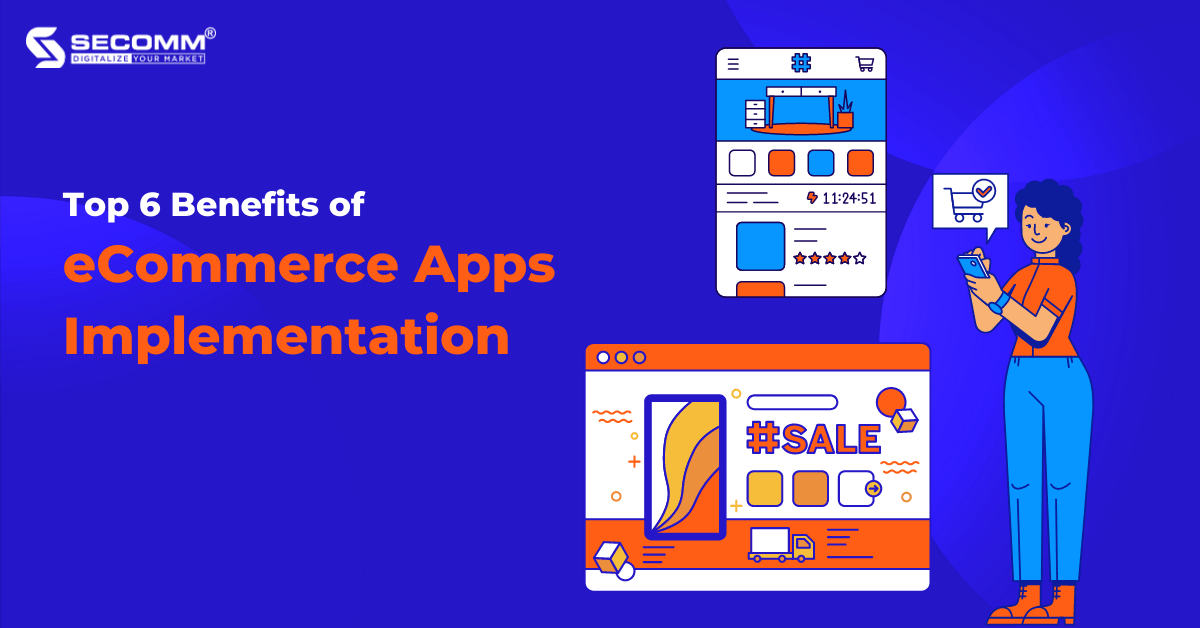
According to data compiled by Forbes Advisor, global Mobile Commerce sales reached $415 billion in 2022 and are expected to reach $710 billion in 2025.
In fact, Mobile Commerce dominates the eCommerce industry, accounting for about 73%, and the use of eCommerce app is growing faster than any other type of app on the market, with an annual growth rate of 54%. This shows that eCommerce app contribute significantly to sales on mobile devices and implementing mobile app is considered the right path for every business in the mobile commerce era.
Increasing brand awareness is one of the benefits that eCommerce app bring to businesses. Since most customers spend hours on mobile devices (e.g smartphones), it’s easier for brands to connect with them through eCommerce app. However, to fully leverage the other capabilities of mobile app, brands need to provide a rich and high-quality app experience. As Statista has noted, about 32%-34% of app users will uninstall if the app is difficult to use or has too many unwanted ads.
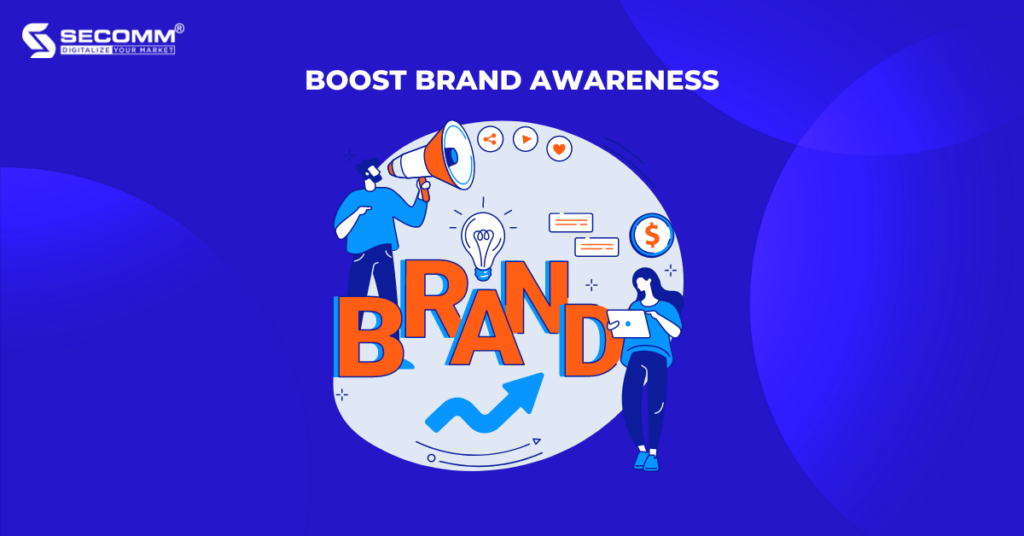
eCommerce websites help deliver personalized shopping experiences with algorithms and support tools but eCommerce apps enable businesses to offer personalized special incentives or promotional programs right in the app without having to access the websites via browsers on desktop or mobile. As a result, among various methods, business owners can combine push notifications, and instead of sending the same push notification to all app users, they can send personalized notifications based on user behavior.
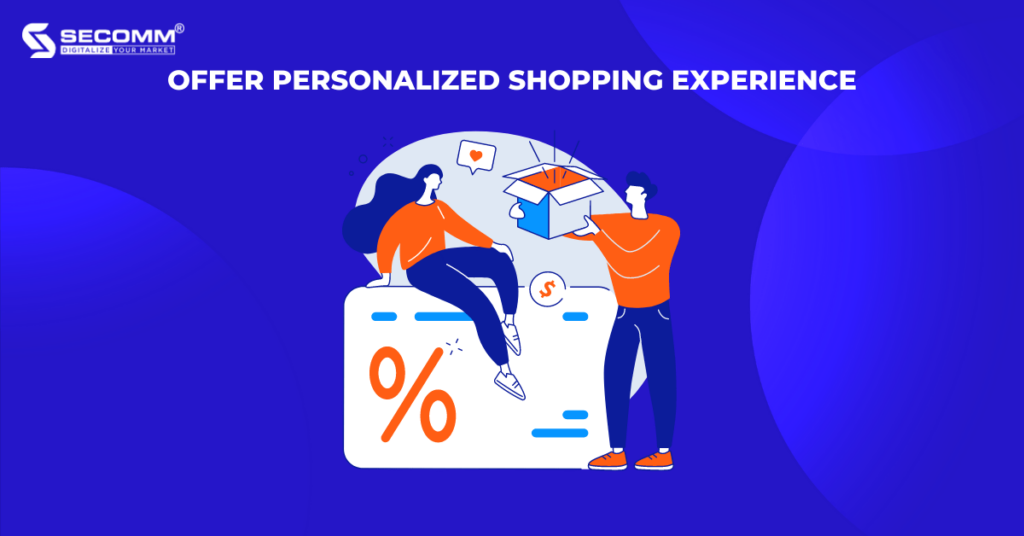
As mentioned, customers tend to love and prioritize shopping on eCommerce mobile app instead of eCommerce mobile web. Therefore, the conversion rate of the mobile app will be higher than that of the mobile web. The graph below indicates the different conversion rates between the mobile app and mobile web.
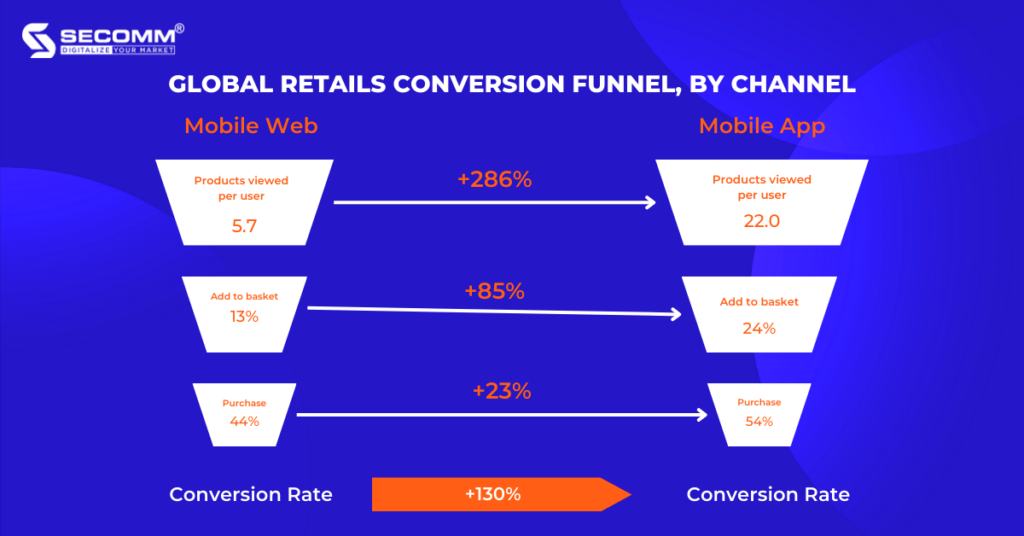
Mobile app users view products more than 286% and add items to the cart at a higher rate of 85% compared to mobile web users. Moreover, the graph shows that the conversion rate of mobile app is over 130% higher than that of the mobile web. Naturally, when the conversion rate increases, it will lead to an increase in sales revenue and profits.
Building an eCommerce app not only boosts brand awareness, enhances customer experience, and improves conversion rate but also increases the average order value (AOV). This is the average dollar amount customers spend each time an order is placed on the app.
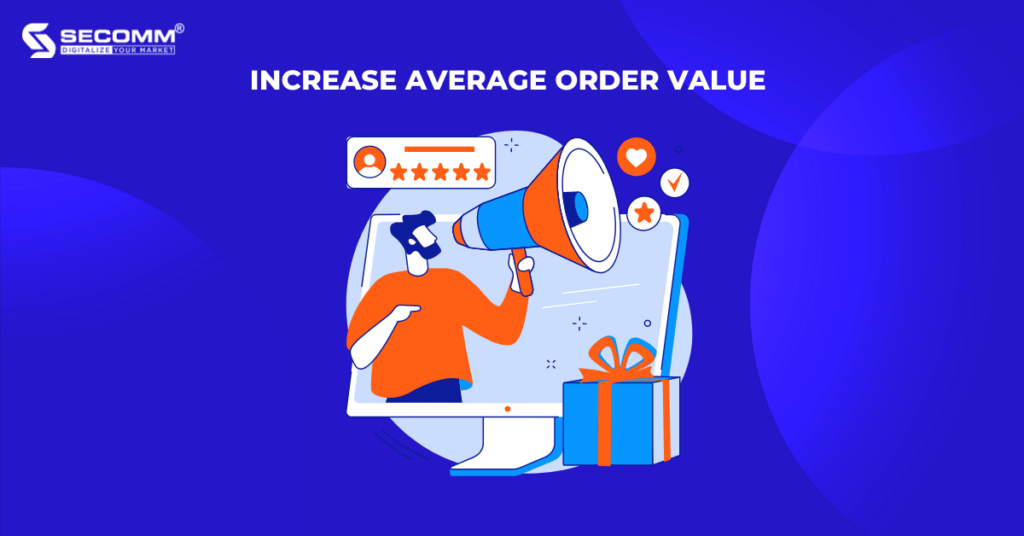
Customers prefer shopping on eCommerce app because it’s convenient for them to browse through products and make purchases. Therefore, they have more opportunities to browse through a wider range of products. This enables businesses to apply cross-selling and upselling techniques, suggesting complementary products to encourage customers to make additional purchases. As a result, the increased AOV drives up revenue and profits.
Some data on cart abandonment has been reported by Ruby Garage:
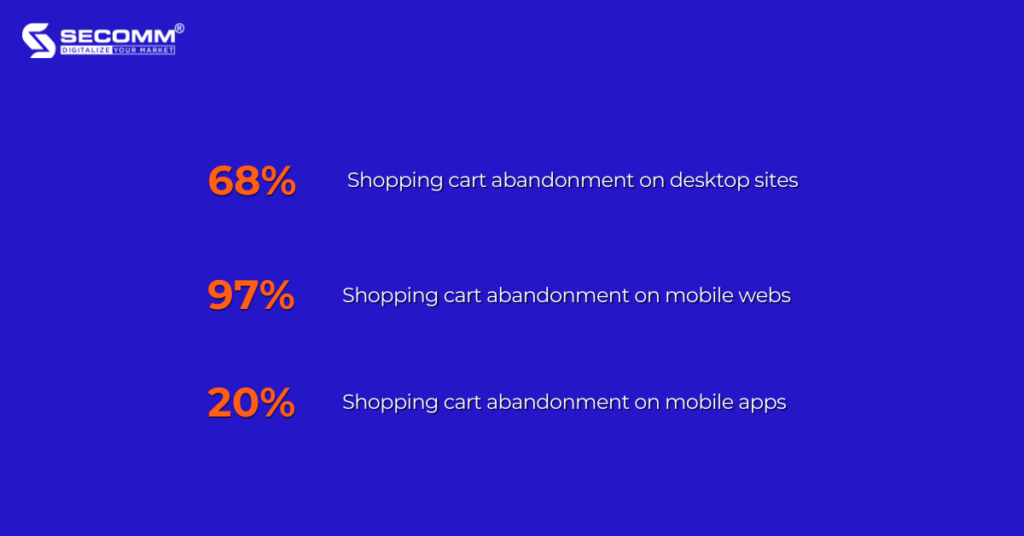
One of the top reasons for that is the long and confusing checkout process. Mobile shopping app will help businesses reduce cart abandonment with the optimized checkout process. When customers buy products, relevant information will be stored in the app’s system, so they don’t have to re-enter their information but complete the purchase with a few taps. In addition, businesses can also shorten the checkout process to improve cart abandonment rates by integrating various payment methods into the shopping app.
For every eCommerce business, increasing sales revenue is a valuable achievement. However, it’s crucial to point out how many regular customers contribute to this success. According to the Harvard Business Review, the cost of acquiring a new customer is more expensive than retaining and satisfying an existing one, ranging from 5-25 times higher. But, if the customer retention rate increases by just 5%, profits can increase from 5% to 95%. As a result, businesses need to put their minds to existing customers.
There is a 50% chance that customers will return to a shopping app within 30 days of their last purchase. In other words, businesses can increase customer retention and loyalty with their mobile app in several ways, including
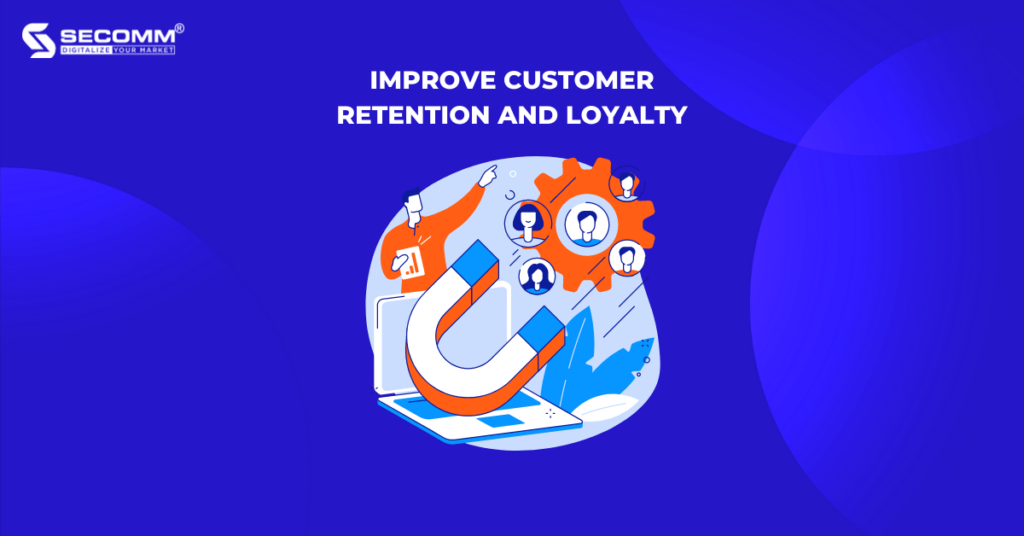
With the incredible benefits of mobile app, businesses are increasingly motivated to quickly build their app to enrich the customer shopping experience while capturing the Mobile Commerce trend.
With years of experience in implementing eCommerce for many businesses in many countries, SECOMM understands the difficulties and obstacles in developing your mobile shopping app.
Contact us today for free advice.
 2
2
 2,844
2,844
 0
0
 1
1
The significant increase in the number of smartphone users has contributed to the rise of Mobile Commerce trends worldwide, including in Vietnam. It’s time for retailers to focus on supporting their customers in searching and shopping through mobile devices, in addition to eCommerce websites.
Many businesses across various sectors, from shopping, healthcare to food, have performed very well in this strategy by becoming pioneers in embracing Mobile Commerce trends in Vietnam.
The SHEIN app is known as one of the most successful eCommerce apps in the world today, and now it has become the most downloaded mobile app in the shopping category in 2022 with 229 million downloads and installs from both Google Play and the App Store.
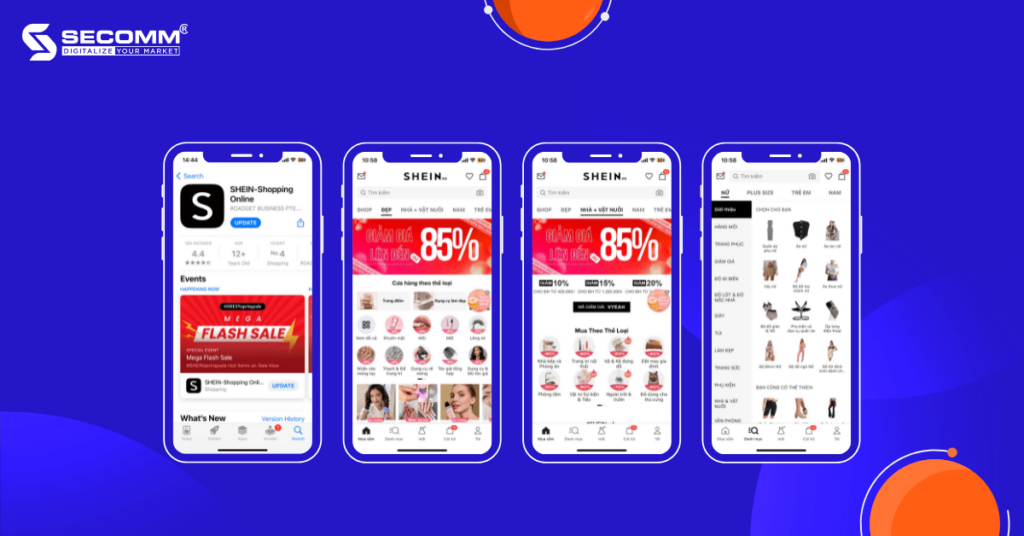
In the Vietnamese market, SHEIN is also highly rated by users for their shopping experience on the app. In the latest update, SHEIN added a discount program for some fashion items of up to 70%, as well as fixing some bugs and improving performance to provide users with a better experience.
Download the SHEIN app: Google Play | App Store
When entering the Vietnamese market in 2019, Uniqlo quickly captured and responded to the local consumers’ fashion shopping trends, which made the brand very popular. The Uniqlo VN app stands out with many necessary functions for a consistent shopping experience between mobile devices and other channels. In order to attract more users, Uniqlo will offer a 150,000 VND discount voucher for anyone who downloads the app and signs up as a new member.
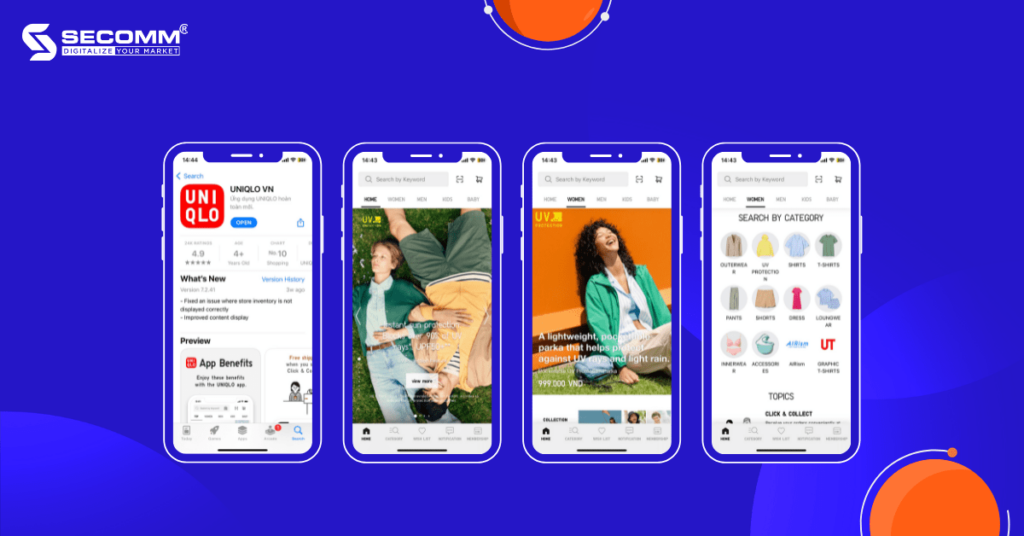
Although the Uniqlo VN app is highly rated for user experience, the brand still keeps updating and improving its features. In the latest update, Uniqlo has improved the quality of product image display and adjusted the accurate display of the number of products available in-store.
Download the Uniqlo VN app: Google Play | App Store
Hasaki not only has nationwide brick-and-mortar stores and an eCommerce website but also develops a mobile app to offer its customers enriched shopping experiences and attractive incentives.
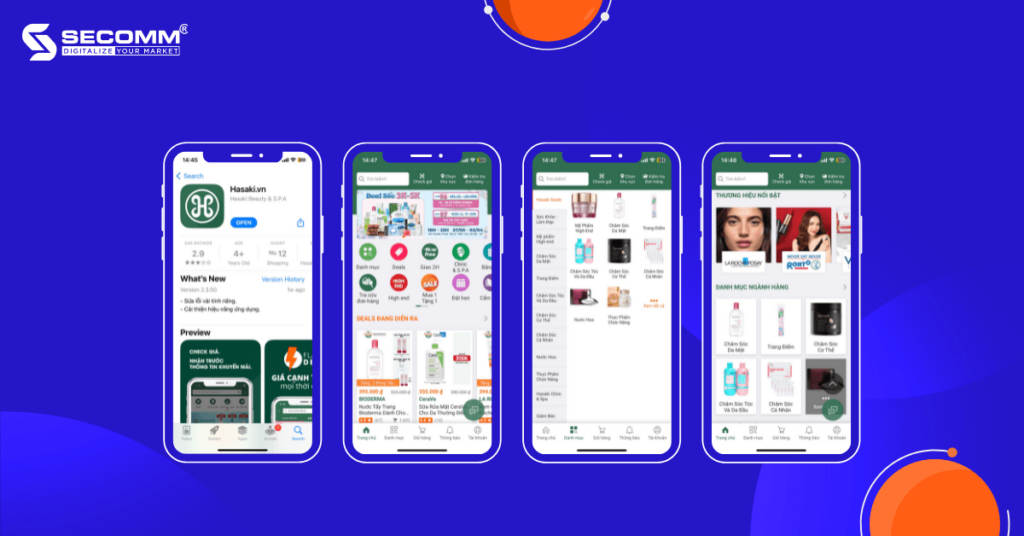
By using the Hasaki app, customers can conveniently search and purchase products anytime, anywhere, track their order status, and make appointments for spa and clinic services at the store. One thing that makes Hasaki special is the free delivery within 2 hours for all customers, whether shopping at the store, eCommerce website, or mobile app. Despite getting much critical feedback for usage quality, Hasaki is still very receptive, fixing bugs and optimizing performance in the recent updates.
Download the Hasaki app: Google Play | App Store
After rebranding, the Big C supermarket chain has been renamed Go!. As a result, the mobile app of this business is now called Go! & Big C. Customers who shop on the app will enjoy many benefits, including:
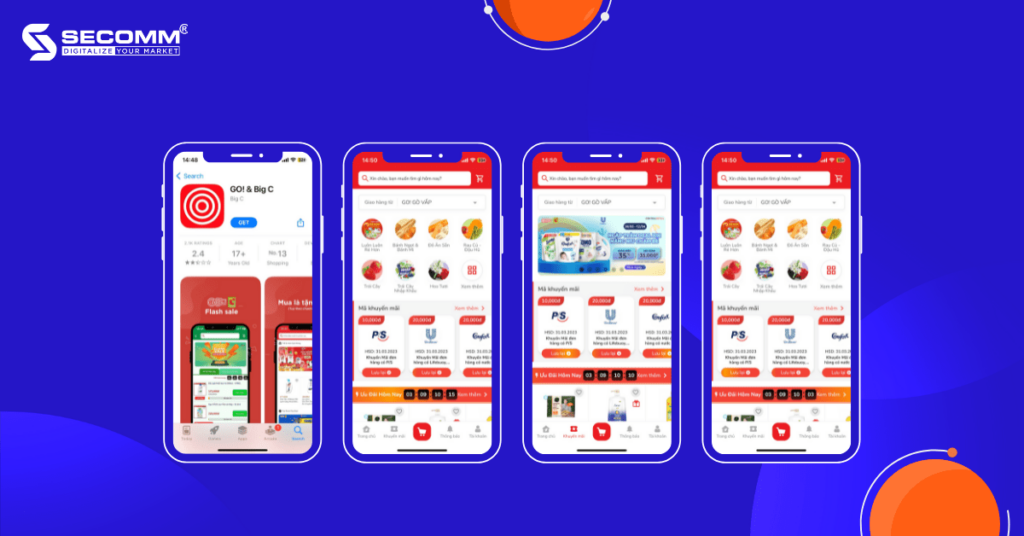
The Go! & Big C app is regularly updated to improve the online shopping experience for customers. In the most recent update, the developer has improved the payment function, fixed bugs, optimized performance, and image display capabilities.
Download the Go! & Big C: Google Play | App Store
Con Cung is one of the first childcare brands to develop its mobile app to provide customers with a consistent shopping experience across different channels, including physical stores, mobile apps, and eCommerce websites.
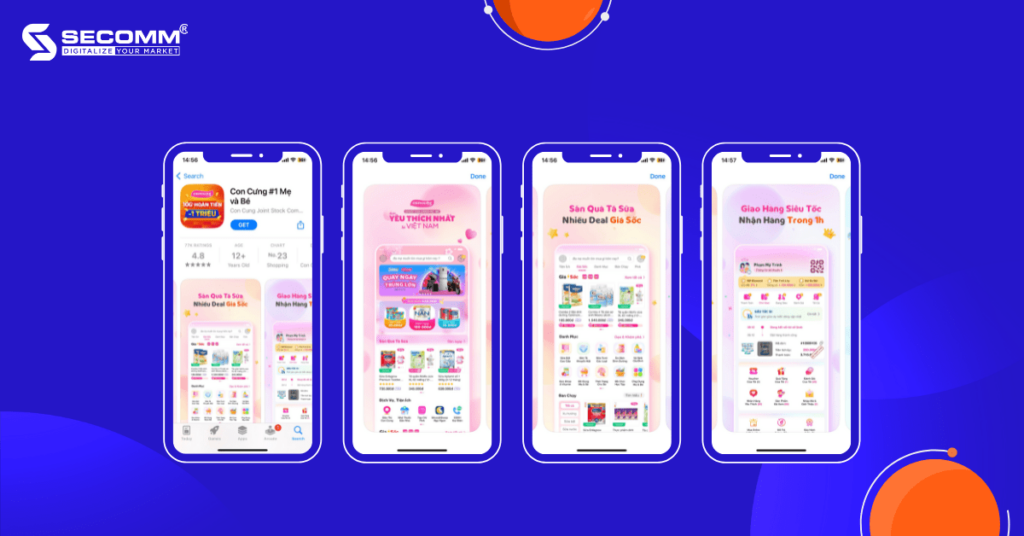
The Con Cung app has received very positive reviews from users on both Google Play and App Store for user experience, product quality, and promotional programs. However, the brand still maintains the practice of testing and improving certain features such as displaying detailed driver’s information when customers place orders for the 1-hour delivery service and fixing bugs related to payment via eWallet.
Download the Con Cung app: Google Play | App Store
Dien May Xanh is a big player in the Vietnamese home appliance industry that has successfully captured the market trend and quickly developed a mobile app to reach the huge smartphone user base in Vietnam – approximately 69 million users.
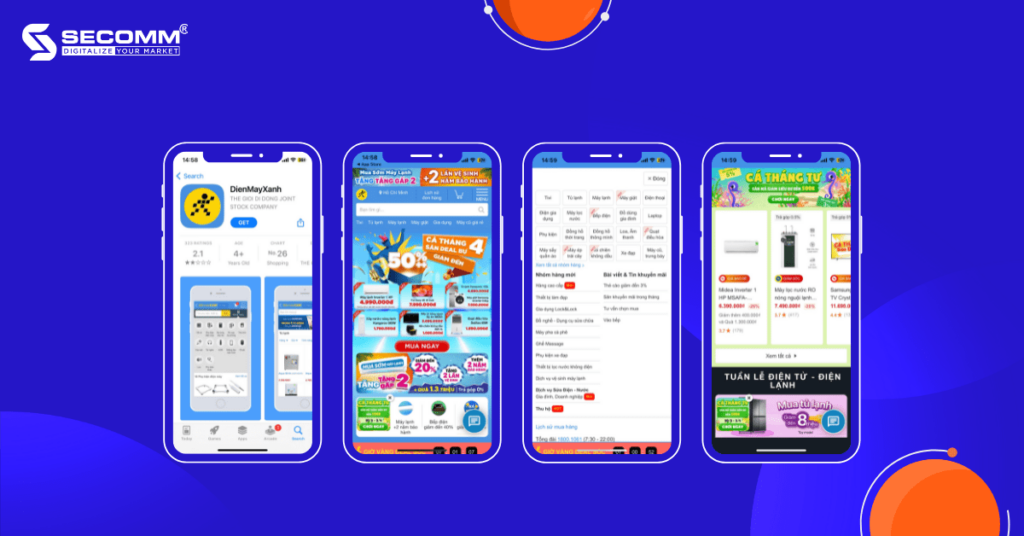
In addition to massive promotional programs on special occasions, Dien May Xanh also provides customers with discounted payment programs using various methods such as Buy Now Pay Later, QR Code, etc. All of these are carried out quickly and easily both on the website and the mobile app.
Download the app: Google Play | App Store
The Vietnamese mobile commerce market has witnessed the entrance of another famous cosmetics retail brand, LixiBox. Similar to Hasaki, LixiBox also continuously updates its app to enhance the shopping experience of customers.
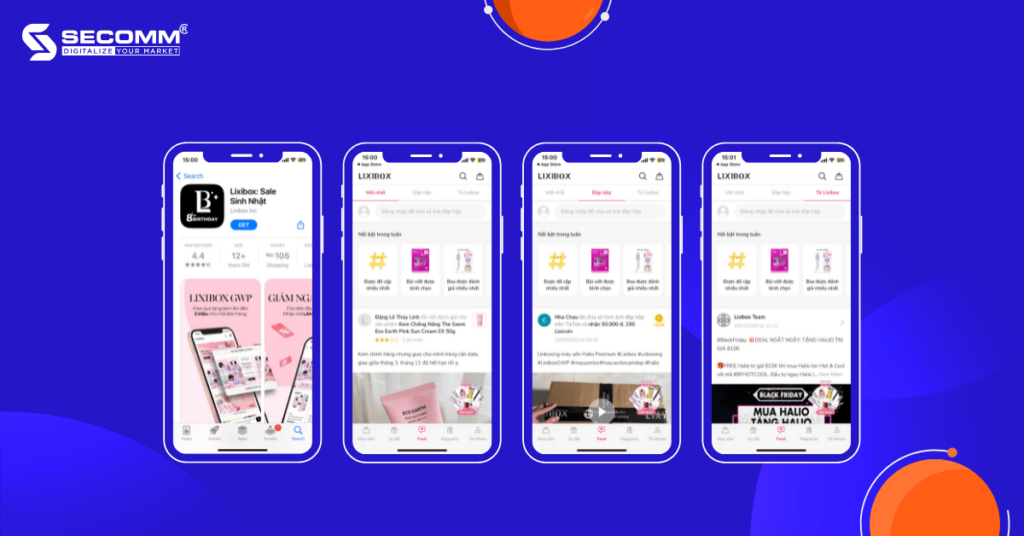
Moreover, the brand offers many special incentives to attract users such as a 20% discount for the first order placed on the app, a referral program where customers can receive 500,000 VND, a magazine section where users can update the latest beauty trends right on the app, and a LixiBox Feed section where customers can share their experiences on products and services.
Download the LixiBox app: Google Play | App Store
When the Long Chau mobile app was launched during the Covid epidemic, it quickly received support from customers everywhere because they could buy medicine and healthcare products online and have them delivered to their door, while also earning reward points for their next purchase. In addition, the app has a call and message feature that allows users to contact pharmacists online for free in-depth advice and support. Furthermore, Long Chau is the first pharmacy to pioneer the Buy Now Pay Later service with 0% interest, helping patients and customers find a new convenient way to make purchases.
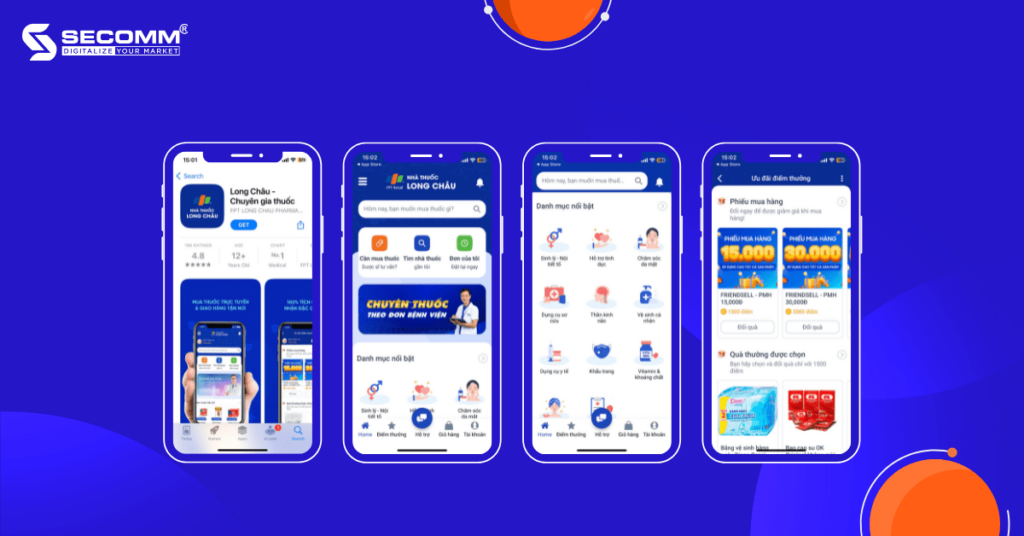
User experience is a particularly important factor that Long Chau focuses on, and the app regularly releases updates. These updates include optimizing the login function, improving the payment function, integrating payment via eWallet, synchronizing order status on the website and app, suggesting reordering, and more.
Download the Long Chau app: Google Play | App Store
Pharmacity is a mobile app developed by the convenient pharmacy chain – Pharmacity in 2018. Similar to Long Chau, the Pharmacity app was created to provide customers and patients with a convenient and fast shopping experience, along with online consultation services from a team of highly specialized pharmacists.
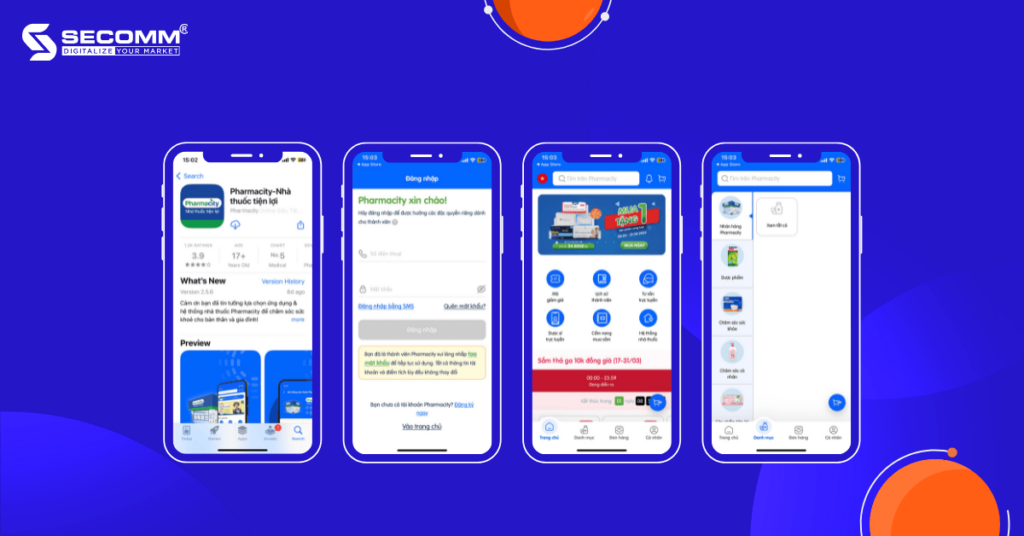
In its latest update, Pharmacity has improved and added some features, including a gift program for first-time users who download the app and sign up as members.
Download the Pharmacity app: Google Play | App Store
In 2021, the famous beverage brand The Coffee House officially launched its mobile app with the same name, aimed at providing customers with the experience of ordering drinks for delivery or picking up at the store, along with many reward point programs for attractive incentives.
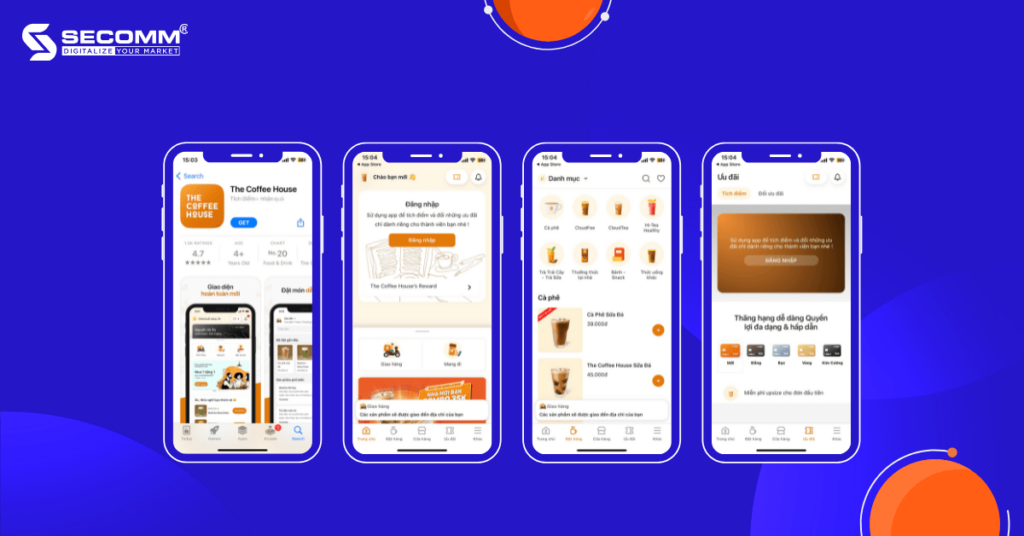
After two years of development, the new version of The Coffee House app features a completely new interface and many special features designed to enhance the customer experience both on the app and at physical stores.
Download the app: Google Play | App Store
Mobile eCommerce apps are one of the rising trends in mobile commerce. As a result, developing mobile shopping apps is the first smart move to achieve sustainable growth in the booming era of mobile commerce.
Contact SECOMM now for advice on how to implement and develop the best strategies to dominate the Mobile Commerce market.
 2
2
 7,067
7,067
 0
0
 1
1
According to the latest data compiled by Statista, as of January 2023, the number of global smartphone users is 6.92B people, increasing by 4.2% annually. In Vietnam alone, this number is around 69 million users, whereas, in the US, Pew Research Center estimates that about three-fourths of Americans own a smartphone. These data demonstrate that smartphones have become common devices, and the demand for owning and using smartphones is significantly increasing.
In addition, the Internet has long ceased to be a high-end infrastructure for countries. Therefore, people today tend to prioritize using mobile devices like smartphones to browse the web.
Typically, Brands tend to establish a strong presence in areas with a wide pool of potential customers, so the emergence of Mobile Commerce quickly gained acceptance and became one of the key business strategies of many enterprises.
Moreover, the appearance of the Covid-19 pandemic in 2020 became a great boost for eCommerce in general and Mobile Commerce, in particular, to explode strongly.
During that period, the smartphone became the shopping companion of users as 79% of users used their smartphones or other mobile devices to shop online, as reported by OuterBox. Despite the eventual end of the pandemic, the Mobile Commerce growth trend is projected to continue as mCommerce retail sales hit $415 billion in 2022, and are predicted to reach $710 billion by 2025.
Mobile Commerce or Mobile eCommerce, abbreviated as m-commerce or mCommerce, is also known as Thương Mại Di Động in Vietnamese. This term was first coined and used by Kevin Duffey at the Global Mobile Commerce Forum in 1997, which means “providing direct eCommerce capabilities to consumers, anywhere, through wireless technology”.
Simply put, it is a business model in which all online monetary transactions are conducted on mobile devices such as shopping, banking, eWallet transactions, ride-hailing, food delivery, hotel reservations, etc.
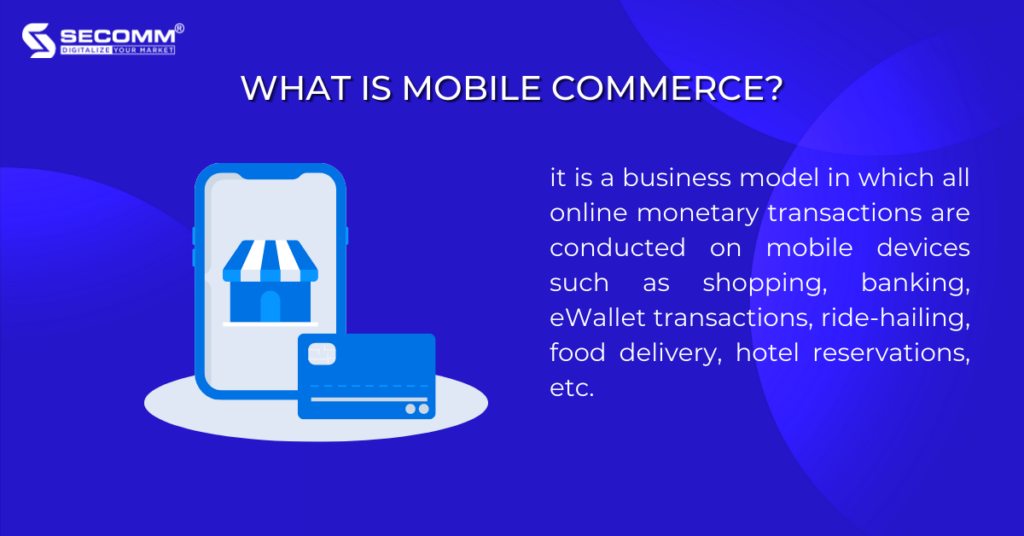
eCommerce or electronic commerce is a relatively broad concept that refers to the buying and selling of goods and services over the Internet. Meanwhile, Mobile Commerce is a branch of eCommerce or the mobile version of eCommerce, specifically referring to electronic commerce transactions carried out on mobile devices.
Furthermore, the eCommerce shopping experience depends heavily on desktops and websites, making it less mobile-friendly and inconvenient for customers. On the other hand, with Mobile Commerce, customers can easily bring their devices with them anywhere, allowing businesses to provide personalized shopping experiences that help customers make quick purchasing decisions.
Thanks to the popularity of smartphones in every consumer’s life, related trends are on the rise such as mobile shopping, mobile payment, and social commerce.
Mobile shopping apps are becoming more and more popular and are the most prominent trend in mobile commerce. Many retail brands across various industries are investing in building and developing their own eCommerce apps such as the fashion industry, the cosmetic industry, and so forth. This not only helps businesses increase their conversion rates and sales but also makes the shopping experience easier and more convenient for customers, as they will be able to search for products and complete purchases right on the app.

In addition, the outbreak of the Covid pandemic and the establishment of social distancing measures in 2020 marked the beginning of the boom of shopping apps. As stated by the Mobile Shopping Report 2021, global usage of shopping apps increased by 40% in Q1 2021.
In the effort to develop sustainably amidst the pandemic crisis, the SHEIN app with nearly 15.5 million global users played a significant role in contributing to the company revenue of $9.81 billion in 2020.
As of 2021, SHEIN’s mobile app reached 43.7 million users and became the second most downloaded app in the world after Shopee. In 2022, SHEIN’s user base grew to 74.7 million and officially became the most downloaded mobile app globally in the shopping category with over 229 million downloads and installations from the App Store and Google Play
The usefulness of smartphones not only lies in online shopping but also makes transactions and payments more convenient and easy during the peak period of the pandemic. In addition to Mobile Banking applications, users have a special preference for mobile wallet or eWallet applications.
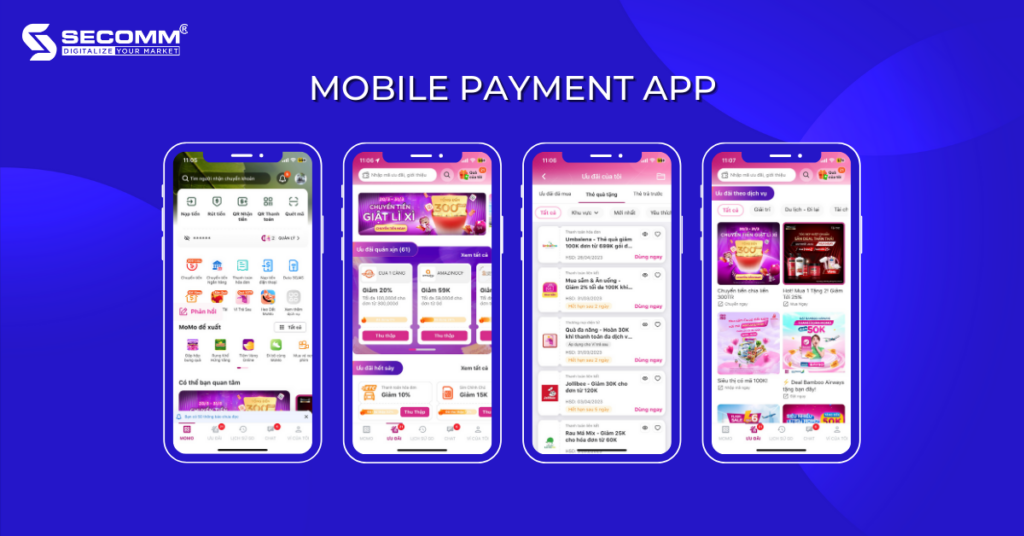
In the Vietnamese market, when it comes to eWallets, people immediately think of MoMo. However, MoMo is not only known as a typical eWallet but also an incredible super application.
To date, MoMo has built a platform that provides about 400 different types of services in many fields such as consumer finance, insurance, money transfer, payment, entertainment, shopping, dining services, and charity donations, etc. The number of MoMo users has increased significantly in recent years, from 10 million users in 2019 to about 31 million users in 2022, and the company’s next target is at least 50 million users.
In addition to making their mobile shopping apps, selling on social media platforms is also one of the widely applied strategies. The popularity and large user base of social media are a solid foundation for the development of Social Commerce and a playground for merchants of all sizes. Social Commerce is a form of online selling through social media platforms like Instagram, Facebook, and TikTok.
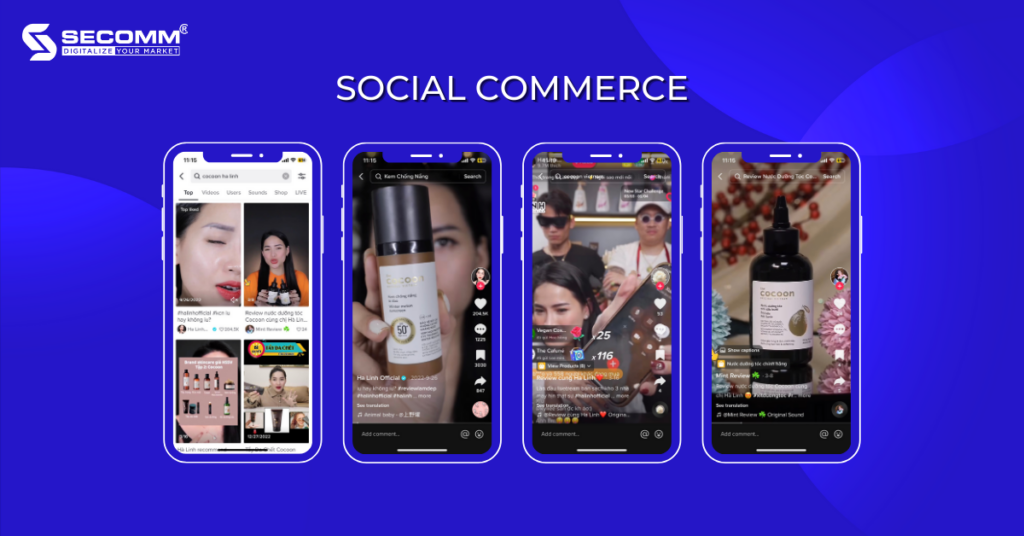
Selling on social media will help brands reach the existing large user base and utilize influencers for their marketing campaigns.
For example, the vegan cosmetics brand Cocoon does this through TikTok Shop. Cocoon is known for its environmentally friendly and animal-testing-free products, and they opened a store on TikTok and collaborated with famous beauty vlogger Ha Linh, which brought them a lot of success. It not only boosted their sales but also reached nature-loving, animal-loving, and young customers on TikTok.
As mentioned, the global number of smartphone users is estimated to reach around 6.9 billion by 2023, which is a driving force for the development of Mobile Commerce. Anyone who owns a smartphone has the potential to become a customer. As a result, implementing Mobile Commerce will help businesses reach this enormous user base, nurture and generate conversions.
In addition, with the mobility of Mobile Commerce, smartphone users with internet access can shop anytime, anywhere, even on the go without being dependent on a fixed location. Especially when visiting a store to shop, instead of paying in cash or by card, customers can now pay through eWallets such as MoMo or VNPay, etc.
Currently, businesses are very focused on personalized customer experience, which is particularly important in the Mobile Commerce world. A smartphone is a personal item that each person carries out personal activities throughout the day. Moreover, in the online shopping trend, customers highly value brands that provide them with a personalized experience because it demonstrates the brand’s concern for its customers. As a result, the more businesses focus on details and personalization in their messages and promotional programs, the better.
For Mobile Commerce, push notifications are an effective solution. Mobile Commerce apps help businesses track and collect user data including personal information, social media accounts, interests, current location, purchase history, viewed products, etc. After that, they can combine and analyze the data to send appropriate messages to the right target audience through push notifications.
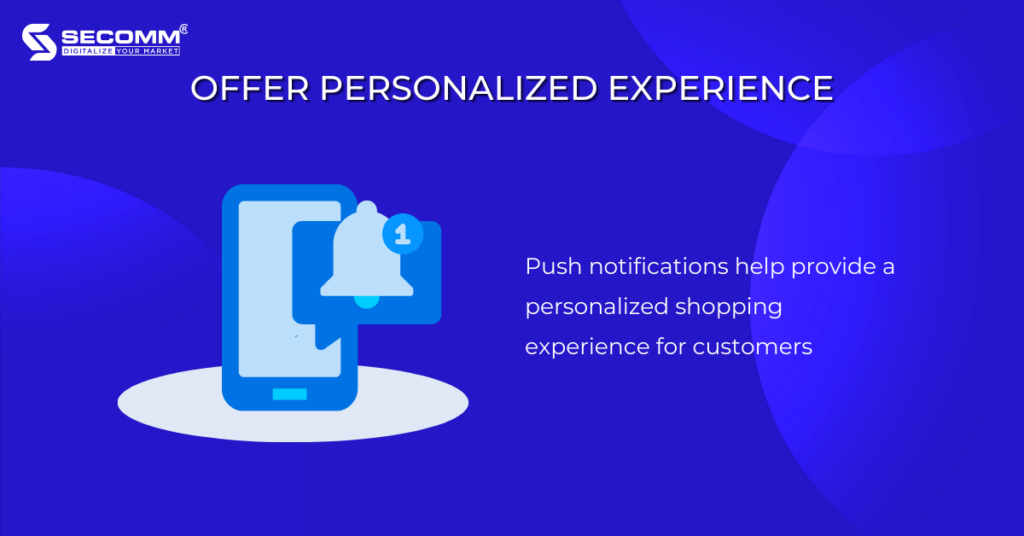
Recent studies have shown the effectiveness of push notifications in connecting with customers and notifying them about new products and special incentives.
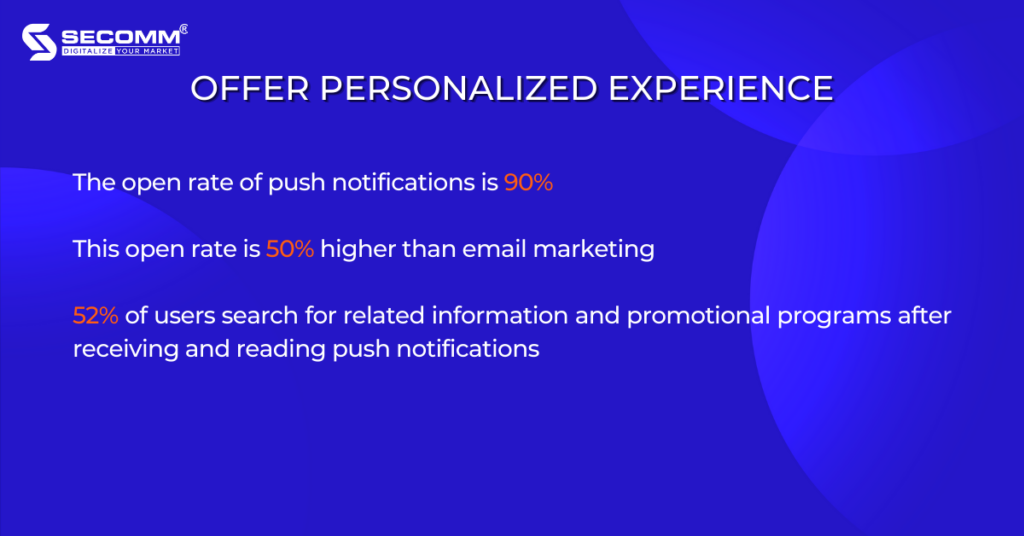
Push notifications are one of the strategies implemented to provide personalized shopping experiences and bring satisfaction to customers. The more satisfied customers are with their shopping experiences, the higher the likelihood that businesses will increase customer retention rates and maintain their loyalty.
The demand for a personalized shopping experience is increasing among customers, as well as the need for a consistent shopping experience across multiple channels, from online to offline stores. According to a study by MasterCard, customers who have a multi-channel shopping experience with a specific retailer tend to spend 250% more than the average. The fashion brand Macy’s has stated that the value of multi-channel shoppers is 8 times higher than that of those who only shop on a single channel.
Moreover, smartphone users tend to use their devices while shopping in offline stores for various purposes, as Retail Dive‘s survey has listed in detail:
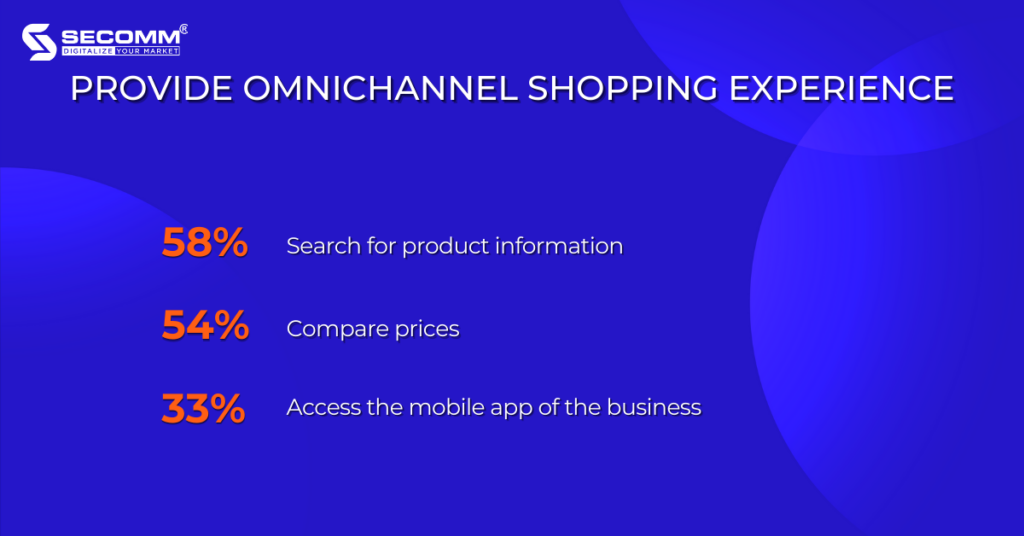
Therefore, by implementing Mobile Commerce, businesses can provide customers with a multi-channel shopping experience.
Mobile Commerce is exploding thanks to the boost from the Covid pandemic. Even though the pandemic has passed, the impact of Mobile Commerce on the development of eCommerce businesses is still significant. If businesses plan to approach Mobile Commerce in 2023, it is a wise decision.
Contact SECOMM today to learn more about Mobile Commerce and the best solutions to get started.
 2
2
 4,821
4,821
 3
3
 1
1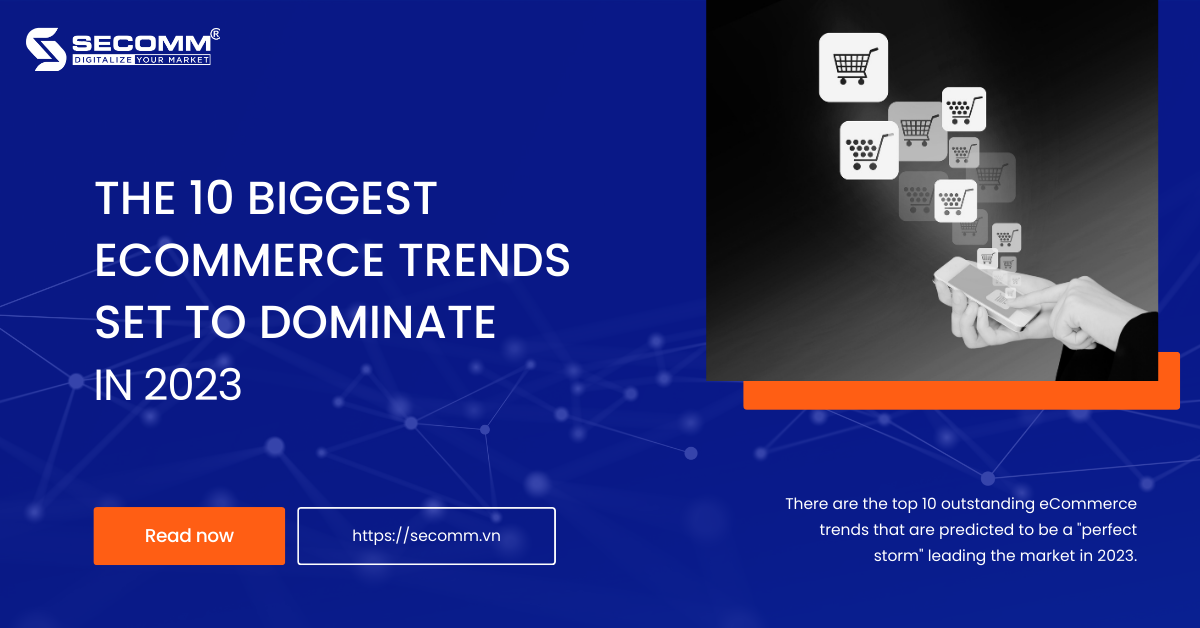
The eCommerce industry has a sizable market share in the Vietnamese economy and has shown impressive growth over the past two years due to the effects of the worldwide pandemic and social isolation.
After a year of society adjusting to the “new normal”, customers have started to buy at traditional stores again but the established trend of eCommerce consumption and the push from the wave of global digital transformation have encouraged businesses to change in order to suit the way the digital economy works.
Therefore, recognizing and anticipating the eCommerce trend of 2023 is extremely necessary for businesses’ New Year’s Marketing strategies to be implemented effectively and successfully.
Below is a list of 10 eCommerce trends that are forecast to “storm” the market in the next year.
Omnichannel is an omnichannel sales model that helps businesses reach customers through many channels such as eCommerce websites, social networks, eCommerce platforms, chain stores, and distribution agents but operating in just one management system.
Additionally, there is a second type of sales model called “Multi-channel” that differs from Omnichannel in that it allows for discrete marketing content, unlinked data, and independent channel operation.
When purchasing across numerous channels, continuous and seamless updates result in a heterogeneous and seamless customer experience.

Due to the lifting of social distance restrictions, consumers are beginning to return to in-store buying after two years of online shopping.
However, that doesn’t mean that eCommerce’s growth momentum is stagnant; on the contrary, it keeps exploding.
Businesses there make use of the current rise in popularity of online shopping to encourage the use of Omnichannel to improve the varied and efficient shopping experience.
As researchers have noted:
As a result, 2023 will still be recognized as a strong year for omnichannel in eCommerce.
Mobile Commerce or mCommerce is a business model that allows companies and individuals to deliver goods and services directly to consumers through handheld wireless devices such as smartphones and tablets.
According to Bankmycell, the number of smartphone users worldwide in 2022 is 6.648 billion, equivalent to 83.07% of the world population owning a smartphone.
Moreover, it is predicted that this number will increase to 7,516 billion by 2026. In addition, the percentage of global users participating in online shopping in 2022 accounts for 58.4%.
In Vietnam alone, interesting figures are listed in the Vietnam eCommerce White Book in 2022:
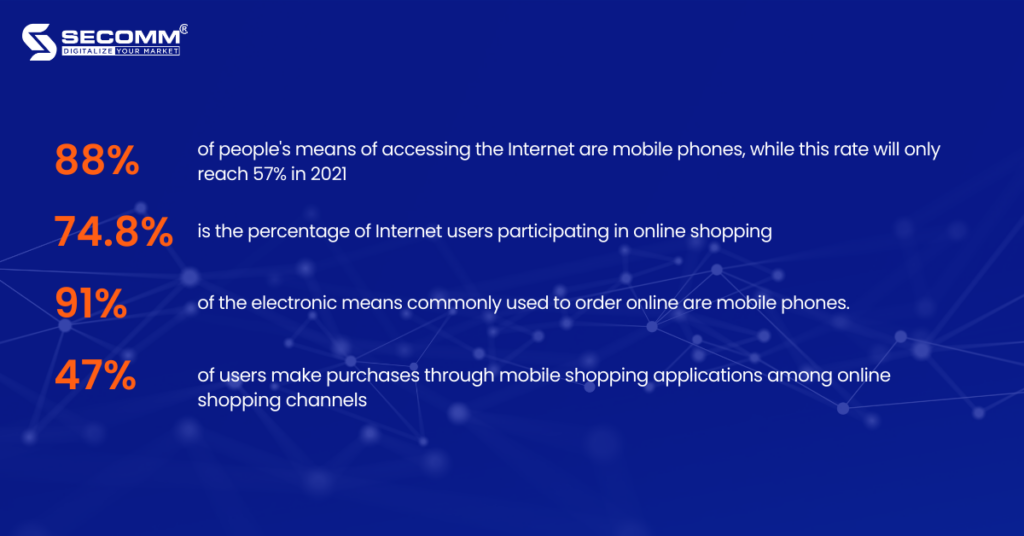
In upcoming years, the percentage of global people and Vietnamese people as well who own mobile devices and use them for online shopping is high and predicted to increase significantly.
Social commerce refers to the method through which companies advertise and sell goods and services online using social networking sites like Facebook, Instagram, TikTok, Youtube, Zalo, etc. In other words, this type of business combines eCommerce and social media.
The impact of social networks has grown significantly in recent years. Over 59% of the world’s population uses social media, it is not surprising that this percentage will continue to rise.
While in the past businesses used social media to raise brand awareness and draw in new customers, today eCommerce businesses boost sales by offering goods and services to clients online via social media.
As a result, it’s incredibly handy for customers to interact, exchange information, and search and shop online all in one location.
According to Statista, global social commerce sales will reach $992 billion in 2022 and are projected to reach nearly $3 trillion by 2026.

Thanks to the development of social networks, social commerce has had a strong acceleration and has become a magnet for brands to come to approach and analyze a large number of potential customers, and achieve marketing and sales goals.
As a result, failing to prioritize social commerce in enterprises’ marketing strategies in 2023 is probably to lead to a significant loss of competitive advantages in the eCommerce market.
Today, businesses have a lot of choices to build an eCommerce website, but basically, the structure of a website will include the following main parts:
For websites using a traditional structure, the frontend and backend will be operated on the same platform and from there will be closely connected with each other. Therefore, any changes on the website will be edited in two parts at the same time. However, with Headless Commerce, the backend and frontend will be decoupled from each other and operate independently on two separate systems.
The benefits of deploying Headless Commerce:
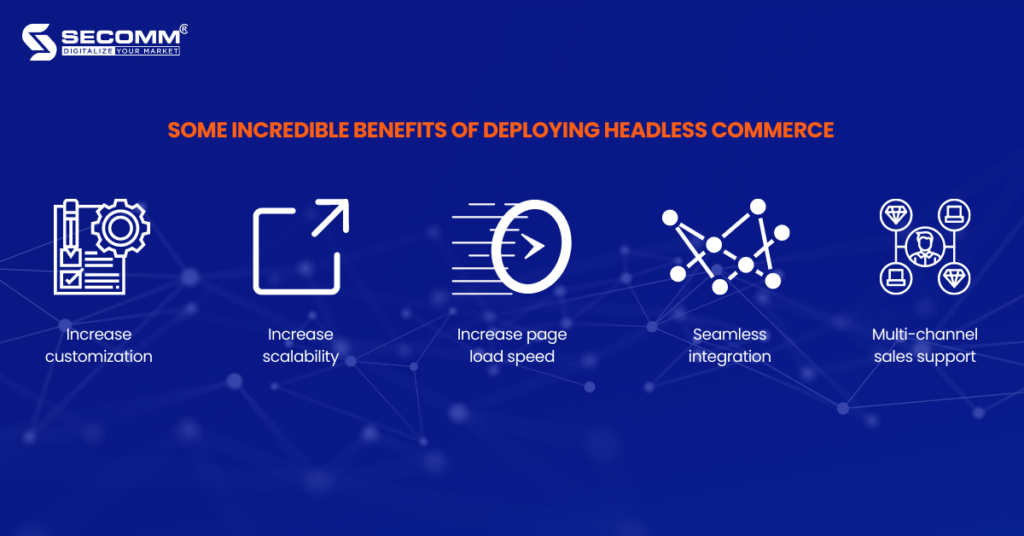
By using the Headless structure, Nike has become a brand with a much larger market share than Adidas – a formidable competitor of Nike.
Moreover, Nike’s website recorded more than 60 million pageviews in just 1 month. In addition, the proportion of direct purchases without intermediaries also increased significantly.
From Nike’s Case Study, one of the practical alternatives for companies looking to encourage eCommerce sales growth is Headless Commerce.
Shoppertainment is a form of shopping combined with entertainment that is used as a marketing strategy to encourage customer engagement with brands and consequently increase shopping demand. Moreover, it is used and takes over most of the online commerce in the era of digital transformation, when eCommerce is positioned at the forefront of contemporary business trends.
Some common practices of Shoppertainment trends:
These three practices all focus on entertainment and interaction. Then, the emotional element is aroused, leading to a series of unwise and unplanned shopping decisions. From a business perspective, this is beneficial for brands. TikTok‘s recent research proves it:
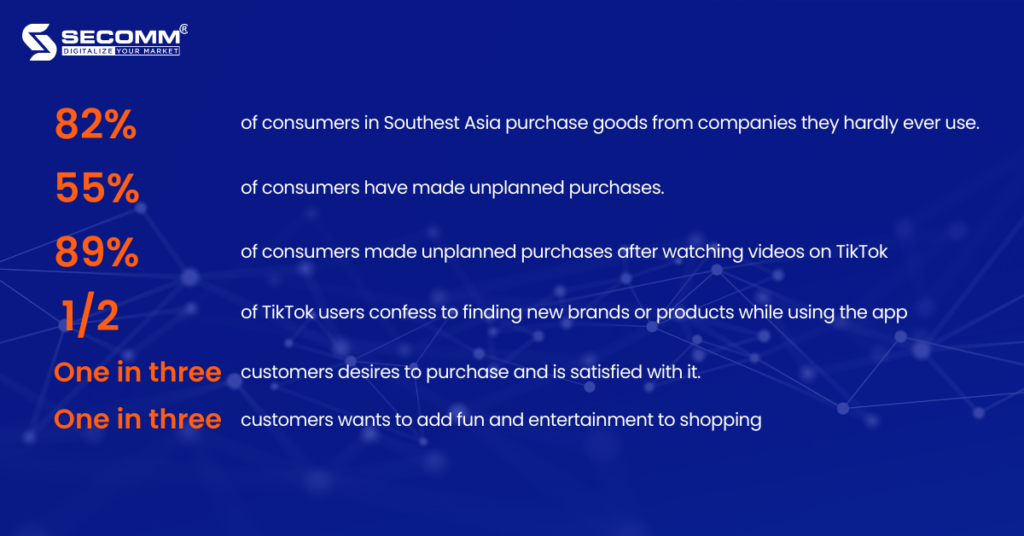
The growth of the Shoppertainment trend in recent years demonstrates the extreme demand for social interaction and connection following the period of Covid’s life.
Shoppertainment is the solution that businesses seek. This is a way to make the most of the customer’s biggest weakness – emotions.
When feelings of euphoria and joy are elicited during the shopping process, customers engage more, and purchase more unplanned products, conversion rates are higher, and sales follow.
Artificial intelligence now has a significant impact on eCommerce businesses in providing solutions to optimize the online shopping experience of customers.
The following statistics demonstrate the incredible influence of AI on the eCommerce market and businesses operating in this field:
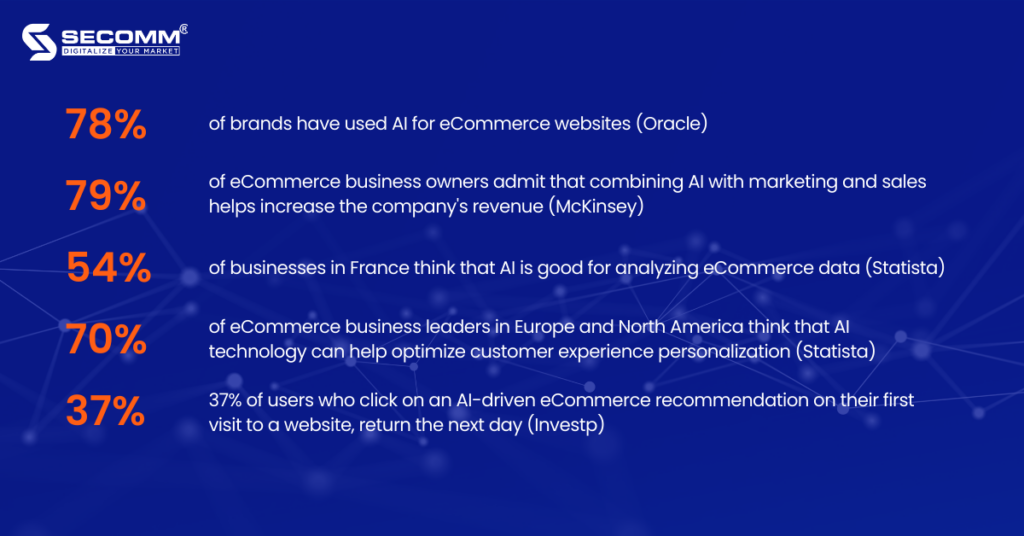
Currently, there are two applications of AI technology that are commonly used in eCommerce:
For eCommerce businesses, Chatbots will be like salespeople who can interact directly with customers 24/7. This helps businesses narrow the distance in terms of geography and time zones, helping the sales and customer services process to take place effectively without interruption.
By collecting customer data, AI can create tailored content and recommendations for each specific customer. To improve marketing campaigns and personalize the customer experience, AI can also predict purchasing behavior based on a user’s browsing and search history, when the data is legally available.
VR (Virtual Reality) is a modern technology that brings users into a simulated but still very realistic space with only 3D glasses (virtual reality glasses). The virtual world that the user sees is actually set up and controlled by a highly configurable computer system.
AR (Augmented Reality) is a new technology enhanced from VR technology. This technology has the potential to erase the boundary between the real world and the virtual 3D model. That is, users will experience virtual models in real space through smartphones or computers.
With a clear plan and the appropriate approach, Lazada has been in front of the augmented reality trend for a number of years and developed a certain competitive advantage in luring both consumers and sellers.
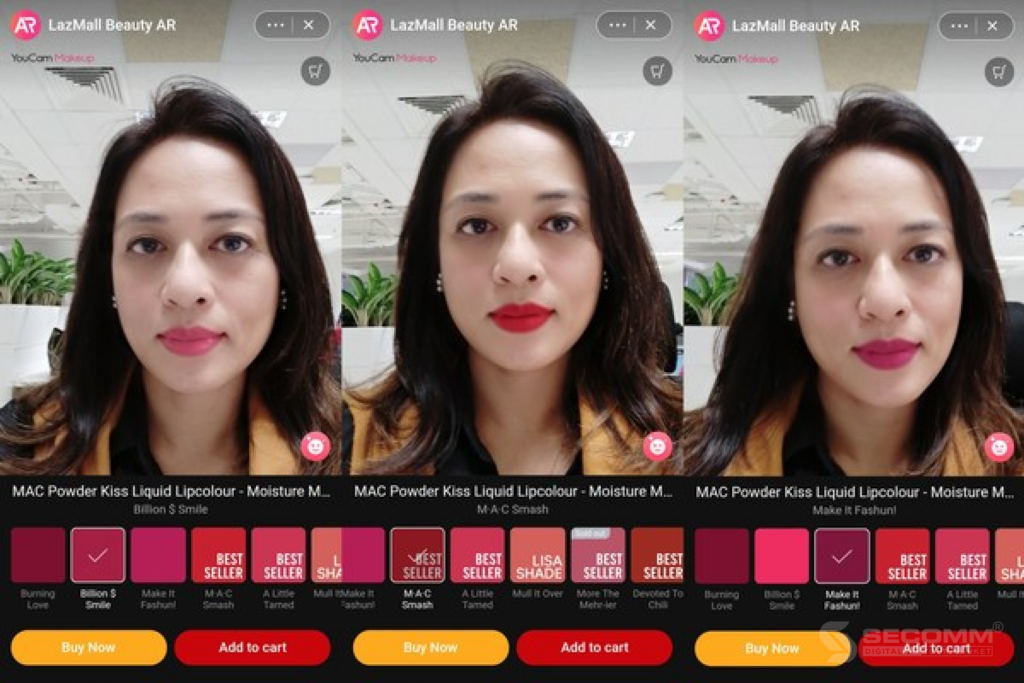
In particular, the VTO (Virtual Try On) function on Lazada includes a wealth of features to assist customers in freely selecting and trying goods like eyeshadow, eyeliner, foundation, and cushions whenever and wherever they like.
Since its launch, LazMall brand partners in the cosmetics sector have experienced tremendous success with the VTO function, which has helped to boost conversion rates by 3.1x and average order values by up to 11%.
The rapid growth of social networks and eCommerce has given marketing efforts a fresh and original breeze thanks to KOL/KOC. Although KOL and KOC have long existed in some form, they have truly taken off in recent years.
KOL – Key opinion leader, also known as an “influencer”, is an individual or organization with expert product knowledge and influence in their field or industry.
KOC – Key Opinion Consumers are “the most influential consumers in the market”. Their job is to test products and services and make comments and reviews.
KOL will suit mid- to high-end brands, while KOC will suit mid-range brands. If KOL is used to select brand ambassadors, holiday season ambassadors, or product launch campaigns, KOC is used to boost sales in a short time or direct customers to websites or eCommerce platforms.
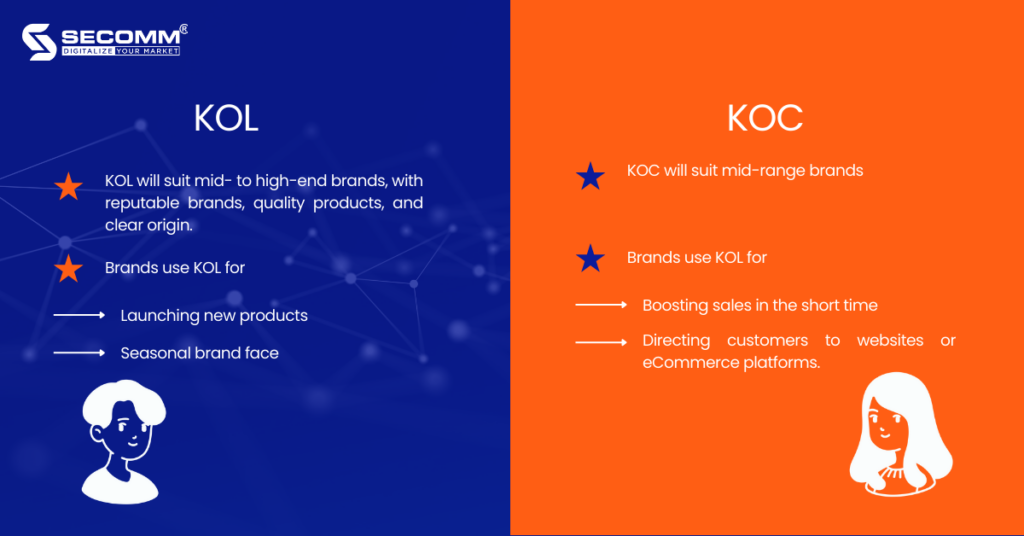
Some famous KOLs in Vietnam: Helly Tong, Giang Oi, Dino Vu, Co em Trendy, Chau Bui, Khanh Vy, Khoai Lang Thang,…
Some famous KOCs in Vietnam: Ha Linh, Call Me Duy, 1m88, Ong Giao Review, Chau Muoi, Hoang Viet, Pu Met 7,…
BOPIS – Buy Online Pick-up In Store is one of the shopping trends that promise to explode in 2023. Customers won’t have to be concerned about shipping costs, extended delivery times, or the risk of receiving unexpected goods when using BOPIS.
Businesses all around the world are pushing up their BOPIS implementation to meet customer expectations when merging online buying with in-person pickup. This is the ideal approach to boost store visits and close the gap between the offline and online buying experiences.
According to GlobeNewswire, the global BOPIS market is projected to reach $703 billion by 2027 with an estimated CARG of 19.3% between 2021-2027.
In addition, the following BOPIS trend statistics can help businesses consider implementing in 2023:
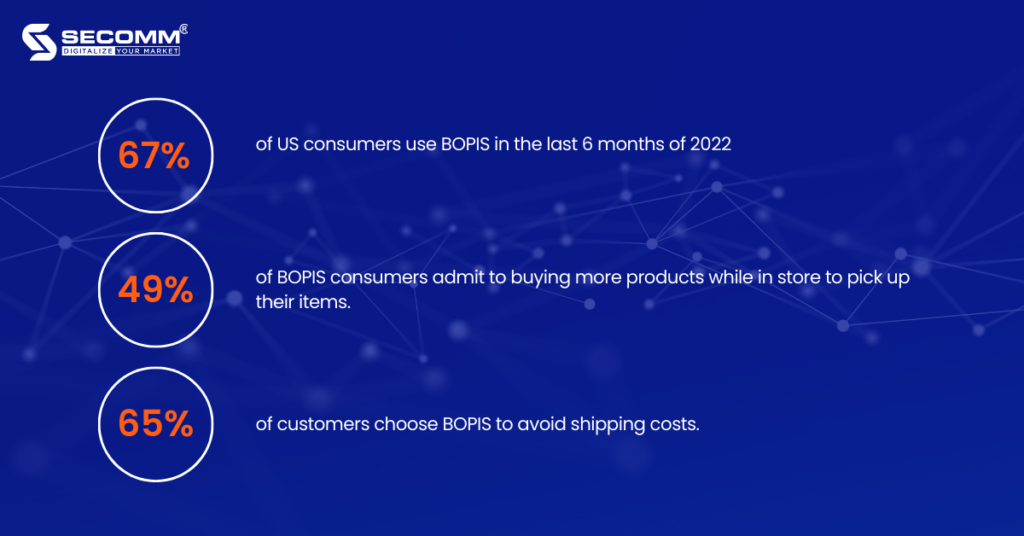
The BOPIS model also aids businesses in cutting expenses, expediting deliveries, boosting demand for retail goods, and lowering the risk of product returns.
User Generated Content, also known as UGC, includes text, photos, video and reviews. Because people are becoming less and less engaged in the brand’s message over the past ten years, UGC has grown in importance.
According to a recent Salesforce survey, 53% of Millennials think user-generated content (UGC) influences their shopping decisions, and 92% of consumers prefer content created by friends and family over that created by brands. The reason for the above numbers is trust.
Therefore, user-generated content (UGC), such as photos, videos, and customer evaluations, is trustworthy social proof and aids in the development of a company’s reputation.
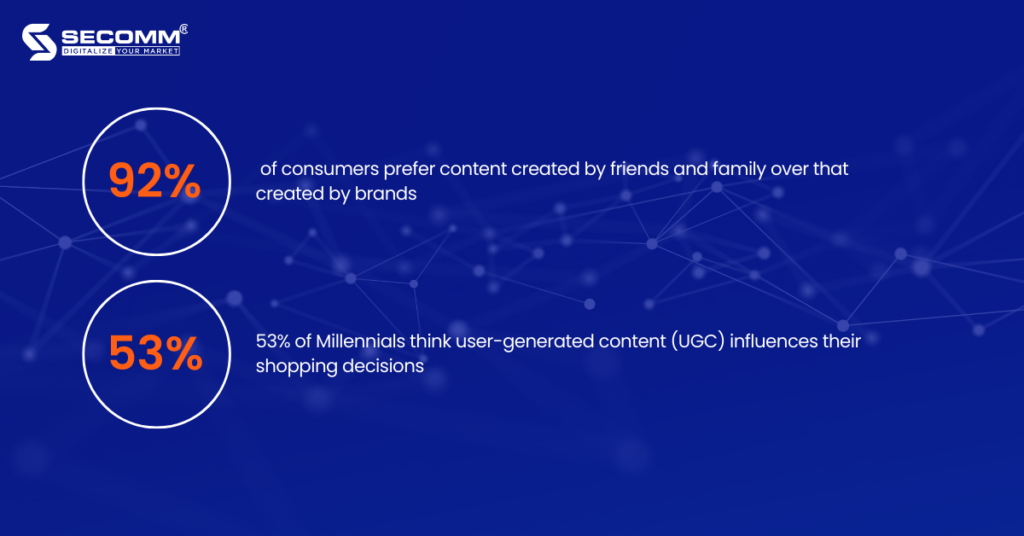
In a nutshell, businesses must quickly adapt to evolving eCommerce and digital technology trends in order to avoid falling behind and being driven out of the market. By reading 10 eCommerce trends that stated and analyzed above, businesses will have an overview to be ready for the new journey.
With many years of experience in successfully implementing eCommerce for many customers in many countries, SECOMM specializes in providing consulting services with comprehensive and professional eCommerce implementation solutions.
Contact SECOMM today for free support and advice.
 2
2
 5,440
5,440
 0
0
 1
1Subscribe to get the latest eBook!
Hotline